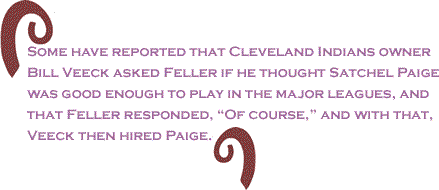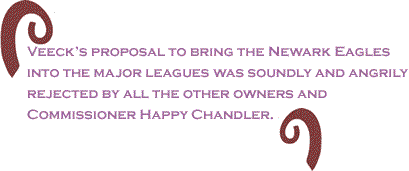Baseball
great Bob �Fireball� Feller, a man whose role in helping
to integrate baseball's major leagues has largely been
overlooked, died December 15th, 2010 from leukemia complications.
Feller,
unarguably one of baseball�s greatest pitchers, joined the
Cleveland Indians, the only team he ever played for, in
1936 as a 17 year old high school junior.
In
1938 he struck out 18 batters in one game, a modern era
record he continues to share with Sandy Koufax and Don Wilson. He
is considered to have thrown more pitches than any man in
history and today his likeness resides in the Hall of Fame.
At
92 Feller was from an era that far preceded the lives of
many of today�s sportswriters and fans. His era is mostly
recorded in dust covered magazines and grainy black and
white photographs. I was born in 1947 and have no memory
of Bob Feller as a player, though I do remember many of
his contemporaries, specifically Minnie Minoso, whose picture
school kids collected from ice cream cups served in the
grade school cafeteria.
But
I did know Bob Feller.
He
and my mom attended the same church.
A
lifetime ago on a wintry December morning in Gates Mills,
Ohio, my mom decided that was as good a morning as any for
me to accompany her to church.
St.
Christopher�s was only a three or four minute walk from
our house but still my sister and I begged off whenever
possible. For some reason she was exempt that morning.

Despite
the foot of snow on the ground mom insisted I go and as
I began to balk as we approached the front door she drew
her service revolver and marched me POW style to church.
That�s an exaggeration but you get the point.
After
a typically dreary service mom and I were talking with our
next door neighbor Cy Paumier, who had just graduated from
Ohio State and had played basketball there.
Suddenly
mom and Cy said almost in unison, �Oh there�s someone you
should meet.�
They
guided me over to a fairly tall but large boned fellow.
The term �corn-fed� was invented for guys just like this.
�Bob
I want you to meet my son.�
Mom
said to me, �Say hello to Bob Feller.�
Even
though Cy already knew Feller he laughed and couldn�t contain
himself, �Fireball Feller!� he laughed.
I
looked at Feller with a blank look on my face but stuck
my hand out.
Feller
extended his catcher�s mitt of a hand that swallowed mine
and smiled. He knew I didn�t have a clue as to who he was
and he didn�t seem to care.
If
my math is correct Feller must have been about 40. He was
large and robust with a quietly confidant air about him-but
very friendly. He had retired just three years earlier.

As
we put our coats on he asked me about sports and my interests.
Then
Cy, myself and Feller stepped outside the church.
A
group of kids were having a snowball fight in street and
I ran out to join the fun. Cy and Fireball were right behind
me.
For
several minutes the battle kept up and soon everyone�s overcoats
were plastered with white dots from expended snowballs.
We enjoyed few minutes of great fun before the grown-ups
took the combatants, the young and not so young, by the
arm and led them home for Sunday dinner.
Over
the next several years I often saw Feller on those occasions
I found myself in church and sometimes we spoke-but it was
not until many, many years later that I really learned who
was Fireball Feller and why so many stood in awe of him.
In
a 2009 interview with Bob Costas conducted at Cooperstown,
Feller related how in 1946, a year before Jackie Robinson
was brought into the major leagues, he and Satchel Paige,
who became a lifelong friend, organized a barnstorming tour
of black and white professional baseball players. The purpose
of the tour was to demonstrate to America that black players
and white players skill levels were equal.
Feller
had just returned from four years service as a gunnery captain
in the navy. He had been the first professional athlete
to volunteer for the armed forces, appearing at the induction
center on Monday, Dec. 8, 1941, just one day after the Pearl
Harbor bombing.
His
time in the service taught him the injustices of the treatment
of African Americans and he promised himself to do something
about it when he returned home.
In
his interview Feller said he footed pretty much the entire
bill for the tour; he chartered two DC-3�s (probably one
of the few times Negro League players didn�t ride a bus
to games) hired a doctor to accompany them and refused to
include overtly racist white players. The teams of course
were integrated.

Some
have reported that Cleveland Indians owner Bill Veeck asked
Feller if he thought Satchel Paige was good enough to play
in the major leagues, and that Feller responded, �Of course,�
and with that, Veeck then hired Paige.
But
Veeck was an unusual owner. At one time he wanted to bring
an entire Negro League team into the major leagues, so it
seems unlikely he�d have questions about Paige�s ability.
Veeck�s
proposal to bring the Newark Eagles into the major leagues
was soundly and angrily rejected by all the other owners
and Commissioner Happy Chandler.
Feller
was also the first president the Major League Baseball Players
Assn, an organization that today is pound for pound this
nation�s most powerful labor organization.
Feller
got in hot water once or twice after the press reported
some statements he made that seemed to some racist.
But
if we can over look Jackie Robinson for testifying before
congress against some of the very people who led demonstrations
to force baseball to hire him, many of whom were black and
ultimately went to prison for expressing their political
beliefs, Feller should easily and likewise be forgiven.
May
a good always man be remembered.

BlackCommentator.com Guest
Commentator, Jean Damu is the Acting Western Coordinator for N'COBRA, the National Coalition of Blacks
for Reparations in America and he chairs the California
Coalition for H.R. 40, Congressman John Conyers' African-American
Reparations Study Bill. Click here to contact Mr. Damu.
|

